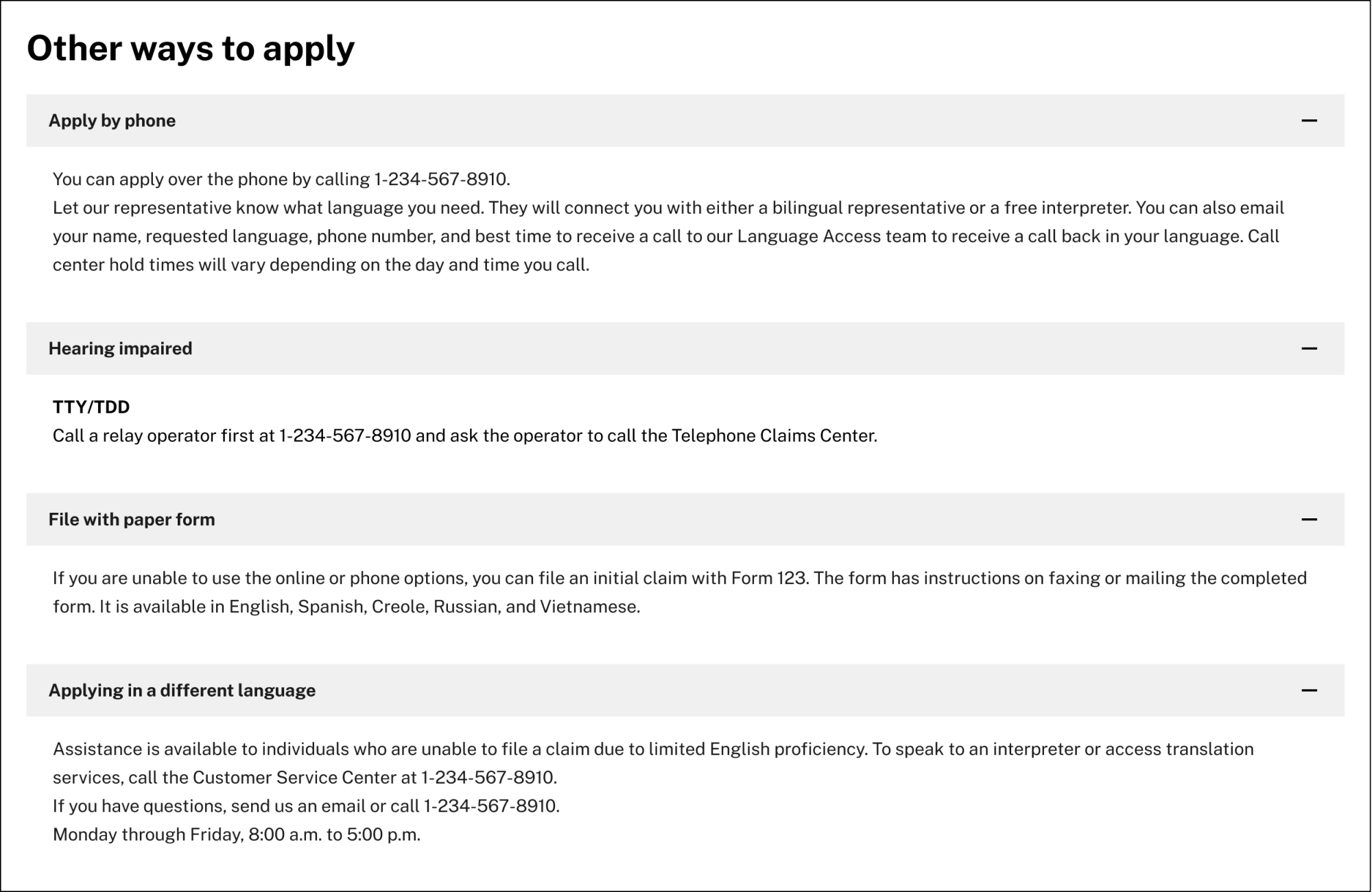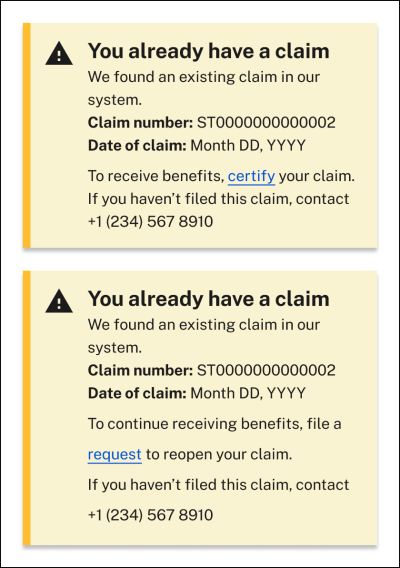For this resource, we conducted interviews with representatives from state workforce agencies, claimant advocate organizations, and experts from the U.S. Department of Labor to identify common pain points for individuals and states by focusing on high-impact sections of the initial application. We then developed recommendations to address these pain points and validated them through follow-up discussions with the same individuals.
Introduction
Setting individuals up for success as they begin the initial claim application starts with establishing clear expectations about the process. Presenting key information up front, including a plain language description of the unemployment insurance (UI) program, an easy-to-understand explanation of eligibility requirements, and a brief overview of what to expect during the process, can help reduce individuals’ anxiety and confusion while increasing their likelihood of completing the application. Providing guidance that is informative yet concise can be challenging, so states should consider what specific information individuals need at each step so they can complete the application as seamlessly as possible.
Below are some specific recommendations states can implement to help individuals feel more confident when applying for UI benefits and to help ensure they are able to provide the correct information so their claims are processed in a timely manner. Accompanying the recommendations are sample language and sample products that states may consider using and customizing with state-specific requirements.
Recommendation 1: Provide individuals with easily accessible information on the unemployment insurance (UI) program and the related requirements so they have sufficient information when they apply.
A common theme among the state workforce agencies and claimant advocate organizations we interviewed was that many individuals lack clear information about the UI program, causing them to feel distrustful about the process. Although states have made efforts to provide detailed information about the UI program and the application process, many individuals are unsure of what documentation and/or previous employment information is required when they apply for UI benefits.
Provide a clear overview of what unemployment insurance is
Related CX principle: Plain language
One theme that emerged from the research is that many individuals lack a clear understanding of what unemployment insurance (UI) is and how it works, causing many to overanalyze or misinterpret some of the questions on the application. Providing an overview of the UI program on the instructions page can help clarify any misconceptions individuals might have about the program before starting the application.
Add a broad, plain language definition of unemployment insurance (UI) within the instructions section before listing any state-specific UI program information. Including this overview content can serve to educate individuals on what unemployment insurance is and how the program works, providing them with much-needed context and visibility into the UI program and the application process.
Sample plain language for process overview
Unemployment Insurance
The unemployment insurance (UI) program acts as a safety net by providing monetary benefits to eligible workers who have lost their jobs. In general, unemployment insurance benefits are intended to replace some of the income you’ve lost to cover expenses while you search for new work.
If you’ve lost your job or had your hours reduced, you may be eligible for up to [ADD STATE’S MAXIMUM NUMBER OF WEEKS]. You can receive from [ADD STATE’S MINIMUM WEEKLY BENEFIT AMOUNT] to [ADD STATE’S MAXIMUM WEEKLY BENEFIT AMOUNT] per week, depending on how much you’ve worked and what you’ve earned in the past.
[PLACEHOLDER FOR ADDITIONAL SENTENCE FOR STATES WITH A DEPENDENTS’ ALLOWANCE: If you have dependents, you may receive up to $XX in addition to your weekly benefit amount.]
Include a brief description of what to expect when applying
Related CX principle: Plain language
Providing transparency into the application process can go a long way in easing individuals’ anxiety about applying for UI benefits. Including a brief description of what’s to come allows individuals to gather what they need to successfully submit their application.
- Provide a checklist that outlines what information and/or documents individuals will need to apply, including personal details, work history, and a time estimate of how long it will take to complete the application. Delivering the content in this format is less overwhelming for individuals and allows them to scan the relevant information quickly and easily. Add bulleted sub-items within each category to provide applicants with additional clarity.

- Ensure individuals are aware that submitting the initial application is just the beginning of the UI benefits process. Consider adding language such as: “In general, to receive unemployment insurance (UI) payments, you will need to certify that you are able to work, available for work, and looking for work (if that requirement applies to you) each week if you want to receive UI benefits for that week.” This way, individuals are aware that there are additional steps to take beyond the initial application.
- Include an unemployment insurance process timeline that describes the upcoming steps in the application process – from answering questions on the application to submitting it.

List eligibility criteria using plain language
Related CX principles: Plain language; Provide contextual help
The research we conducted also revealed that individuals found the eligibility requirements section of the application to be confusing. Many individuals don’t understand the technical UI terminology used while others are uncertain if the eligibility scenarios provided match their specific situation.
- Use plain language when outlining eligibility requirements by using phrases and terms individuals can easily understand.
Sample plain language for eligibility requirements
To qualify for unemployment benefits, you must:
- Be unemployed or have had your hours reduced
- Be ready and willing to take on suitable work
- Be actively seeking a job
- Avoid terms such as “benefit year” or “base period” unless states can include a plain language definition or example to clarify what these UI terms mean.
Sample plain language for “benefit year” definition
To be eligible for unemployment benefits, you must have sufficient recent earnings [placeholder for states that use hours worked] during a 12-month period [or insert dates].
- Although independent contractors, freelancers, and gig workers generally don’t qualify to receive unemployment benefits, there are exceptions. To ensure these individuals are not dissuaded from applying for unemployment insurance, consider adding language to let these individuals know they should apply for benefits even if they are unsure they will qualify.
Sample plain language for worker types
Not all types of workers are potentially eligible to receive unemployment benefits. The best way to check if you might be eligible for benefits is to apply.
Provide a complete list of required documentation, including specific requirements for non-citizens, military personnel, and federal workers
Related CX principle: Plain language; Provide contextual help
Individuals often struggle with gathering all the required documentation when applying for UI benefits. When applicants are unsure about what documents are needed or where to find the information requested, they may get frustrated or stop working on the application altogether.
Add a list of required documents for all categories of individuals, including the following groups (refer to the sample checklist provided):
Non-citizens – If you are not a U.S. citizen, you’ll need proof of authorization to work in the U.S. such as:
- Permanent Resident Card (also known as U.S. Green Card, Resident Alien Card, or Form I-551)
- H1B visa or an unexpired foreign passport with Form 1-94, Form 1-94A, or I-551 stamp
- [LIST OTHER EMPLOYMENT AUTHORIZATION DOCUMENTS THE STATE ACCEPTS HERE]
Military – If you served in the military during the last 18 months, you’ll need your DD Form 214, Member 4 Copy, or Service Copy.
Federal workers – If you were a federal employee during the last 18 months, you’ll need your Standard Form SF-8, Notice to Federal Employee About Unemployment Insurance or SF-50, or Notice of Personnel Action.
Include information about ways individuals can apply
Related CX principle: Plain language
States must offer more than one way to apply for unemployment benefits since one method will not work for everyone. Providing more than one method of applying increases equitable access for individuals, such as those with language or literacy barriers, those who lack access to a computer or broadband, or those with disabilities. Offering alternate ways to apply also helps those who run into issues with the online application and require offline support to complete it.
- List up-to-date contact information, such as office and/or call center phone numbers and working hours, prominently on the online instructions page. This will ensure individuals can readily speak with a UI representative when needed.
- Instruct individuals who require assistive technology on ways they can apply. Visit the Web Accessibility Initiative website to understand how people use assistive technology and how people with disabilities use the web.

Recommendation 2: Provide clear guidance to individuals as they evaluate how and where to apply for unemployment benefits
We spoke with state workforce agencies and claimant groups and they highlighted two areas where additional guidance would be particularly helpful for individuals applying for benefits. First, they shared that individuals who have worked outside of their state are often not sure if they are applying for benefits correctly, including whether they are applying in the right state. Second, some individuals are unsure if they have an existing claim in the system and, if so, whether they need to file a new claim or take further action on the existing claim. Here are some improvements states can make to ease any confusion individuals might have with these issues during the initial application.
Assist individuals in determining in which state to file their claim
Related CX principles: Plain language; Provide contextual help
Individuals who have worked in another state, in multiple states, or who have worked remotely for an employer located in a different state are often unsure where to apply for unemployment insurance. States can guide these individuals in the following ways:
- Inform individuals that eligibility laws and benefits vary by state.
- Instruct individuals to apply in the state where they actually performed the work. If they worked in multiple states, they may have a choice of where to file the claim. Provide contact information for agencies in other states, if applicable. (States can search for state UI agencies’ contact information using the unemployment benefits finder.) Consider this sample text.
Do you work in a different state than your employer? Or have you worked in more than one state? Most states require that you file for unemployment insurance (UI) benefits in the state where you performed the work, even if your employer is located in a different state. However, rules vary state to state. Contact the UI agency in the state where you most recently performed work for specific filing instructions. [States should add or embed a link to the state UI agency website]
- Include a question asking where the individual performed their work and then provide dynamic helper text explaining they might need to apply in a different state. Consider this sample alert, which would appear only for those individuals who indicate they did not perform federal or military service.

Offer an automatic system check for existing claims
Another potential roadblock is not understanding when a new claim should be filed or an existing claim should be reopened. Some individuals file an additional claim when they, instead, should reopen their existing claims. Other individuals file multiple claims when they, instead, should be certifying their eligibility on their existing claims to receive weekly benefits. Providing guidance on what action an individual needs to take if they have an existing claim can prevent unnecessary frustration and potential payment delays. Refer to the examples provided.
- Implement a real-time feature that checks if individuals have an existing claim for the current benefit year.
- Provide guidance in case the individual should reopen an existing claim or certify for the week instead of filing a new claim.

